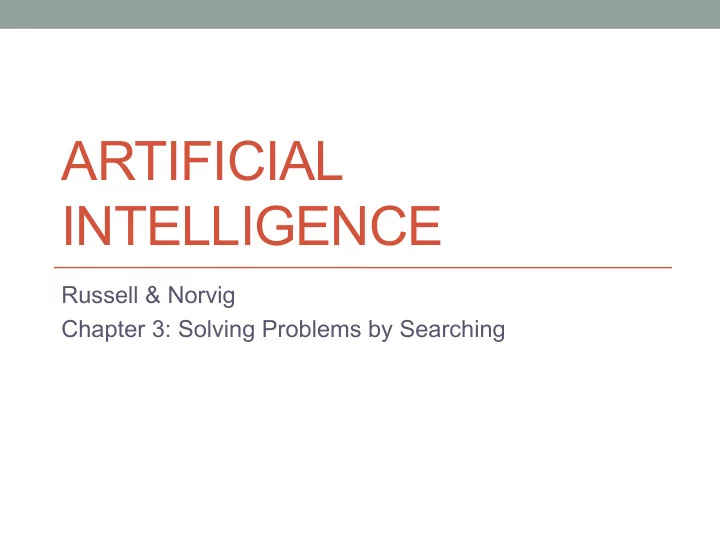

ARTIFICIAL INTELLIGENCE Russell & Norvig Chapter 3: Solving Problems by Searching
Problem-Solving Agents • Goal is set of states where goal is achieved • Must consider level of abstraction to formulate problem • Which actions are important in problem solution? • Typically consider situation of solving problem “offline” then executing the planned solution • While executing plan, percepts are ignored Process: Formulate problem è Search è Execute
Problem-Solving Agents
Simple roadmap of Romania
Problem definition components 1. Initial State • For example, In(Arad) 2. Possible Actions • For state s, Action(s) returns actions that can be executed in s • Actions(In(Arad)) = {Go(Sibiu), Go(Timisoara), Go(Zerind)} 3. Transition Model • Successor function, like delta ( δ ) transitions in finite state machines • Together, initial state, actions and transition model define the state space 4. Goal Test • Similar to “final state”, e.g. {In(Bucharest)}, or abstract property (checkmate) 5. Path Cost • Agent’s cost function used as internal performance measure. Usually sum of cost of actions along path from initial state to goal state
Vacuum cleaner world
8-puzzle (sliding-block puzzle) • 3x3 board with 8 numbered tiles and a blank • Any tile adjacent to blank can slide into blank spot • States: any configuration, e.g.: 7,2,4,5,0,6,8,3,1 • Initial state: any • Actions: easiest to specify moving of blank space (ULDR) • Transitions, Goal, Path Cost?
Route-finding problem • Like the Romania example • Lots of applications—web sites, in-car systems, airline systems, etc • For any of these can define problem with respect to: • States • Initial state • Actions • Transition model • Goal test • Path cost • Other variations: robot navigation, TSP, etc
Formulating Navigation Problem • Set of States • individual cities, e.g., Memphis, Oxford, Batesville, Jackson, New Orleans, Biloxi, Mobile, Little Rock • Operators • freeway routes from one city to another • e.g., Memphis to Jackson, Biloxi to Mobile • Start State • current city where we are, Oxford • Goal States • City or set of cities that represent a final destination, e.g., New Orleans • Solution • a sequence of operators which get us there, • e.g., Oxford, Batesville, Jackson, New Orleans
Tree-based Search • Basic idea: • Exploration of state space by generating successors of already- explored states (a.k.a. expanding states). • Every state is evaluated: is it a goal state ? • In practice, the solution space can be a graph, not a tree • E.g., 8-puzzle • More general approach is graph search • Tree search can end up repeatedly visiting the same nodes • Unless it keeps track of all nodes visited • … but this could take vast amounts of memory
Tree Search Example
Tree Search Example
Tree Search
Graph Search
Search Strategies • A search strategy is defined by picking the order of node expansion • Strategies are evaluated along the following dimensions: • completeness: does it always find a solution if one exists? • optimality: does it always find a least-cost (optimal) solution? • time complexity: number of nodes generated • space complexity: maximum number of nodes in memory • Time and space complexity are measured in terms of • b: maximum branching factor of the search tree • d: depth of the least-cost solution • m : maximum depth of the state space (may be ∞ )
Recommend
More recommend